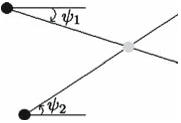




Did you find this useful? Give us your feedback


















989 citations
484 citations
...The substitute method is to estimate the distance of unknown node to reference node from some sets of measuring units using the attenuation of emitted signal strength [3, 12]....
[...]
451 citations
...For a review of these techniques, see Hightower and Borriello (2004) and Gezici (2008)....
[...]
418 citations
348 citations
...(AoA,ToA,TDoA, andRSS), coverage, and cost [12, 13]....
[...]
11,409 citations
4,317 citations
In the absence of synchronization between the target node and the reference nodes, the TDOA estimation can be performed if there is synchronization among the reference nodes [1].
The main idea behind position estimation via mapping techniques is to determine a regression scheme based on a set of training data, and then to estimate position of a given node according to that regression function.
For independent noise components, the likelihood function in (23) can be expressed asp(z|θ) = Nm∏i=1 pηi (zi − fi (x, y) | θ), (24)where pηi (· | θ) represents the conditional probability density function for the i th noise component given θ
(22)Note that since f(x, y) is a deterministic function, the likelihood function can be expressed asp(z|θ) = pη(z − f(x, y) | θ), (23) where pη(· | θ) represents the conditional probability density function of the noise vector conditioned on θ .
The geometric techniques can also be applied to hybrid systems, in which multiple types of position related parameters, such as TDOA/AOA [31] or TOA/TDOA [32], are employed in position estimation.
In order to obtain accurate TOA estimation in multipath environments, high-resolution time delay estimation techniques, such as that described in [17], have been studied for narrowband systems, and first path detection algorithms are proposed for ultra-wideband (UWB) systems [14,18–20].
For a noise vector modeled as a multivariate Gaussian random variable with mean µ and covariance matrix , the likelihood function is given byp(z|θ) = 1 (2π)Nm/2| |1/2 exp{ −12 (z − f(x, y)− µ)T −1 (z − f(x, y)− µ)} . (28)Then, the ML position estimator can be calculated asθ̂ML = arg min θ (z − f(x, y)− µ)T −1 (z − f(x, y)− µ)+ log | |, (29)where θ consists of the position of the target node and the unknown parameters related to µ and .
Since the effects of the propagation environment, such as the multipath, are not known at the time of TOA estimation, the use of a template signal or a MF impulse response that includes the overall effects of the channel is not usually possible.
The main principle behind the AOA estimation via antenna arrays is that differences in arrival times of an incoming signal at different antenna elements include the angle information if the array geometry is known.
In vector notations, the model in (17) can be expressed asz = f(x, y)+ η, (19) where z = [z1 · · · zNm ]T , f(x, y) = [ f1(x, y) · · · fNm (x, y)]T , and η = [η1 · · · ηNm ]T .Depending on the available information related to the noise term η in (19), parametric or non-parametric approaches can be followed.
In some positioning systems, two or more of the position related parameters, studied in the previous subsections, can be employed in order to obtain more information about the position of the target node.
In its simplest form, the k-NN estimation technique estimates the position of the target node as the position vector in the training set T corresponding to the parameter vector that has the shortest distance to the given (estimated) parameter vector m.
In other words, when the position lines intersect at multiple points, instead of a single point, due to certain errors in the parameter estimation step, the geometric approach does not provide any inside as to which point to choose as the position of the target node.
the combinations of the phase shifted versions of received signals at different array elements can be tested in order to estimate the AOA [1].
the accuracy depends on estimates at all nodes, LOS and NLOS, since the effects of NLOS propagation are implicitly included in the RSS signal model, as studied in Sect. 2.1.For an AOA-based positioning system employing ULAs, the MMSE can be expressed as [8]
In the first step of a two-step positioning algorithm, signal parameters, such as time-ofarrival (TOA) and received signal strength (RSS), are estimated.
One of the disadvantages of geometric techniques is that they do not provide a theoretical framework in the presence of noise in position related parameters.
In general, the noise components may also depend on the position of the mobile, in which case θ includes the union of the elements in λ, x , and y.
As this example illustrates, the geometric approach does not provide an efficient data fusion mechanism; i.e., cannot utilize multiple parameter estimates efficiently.